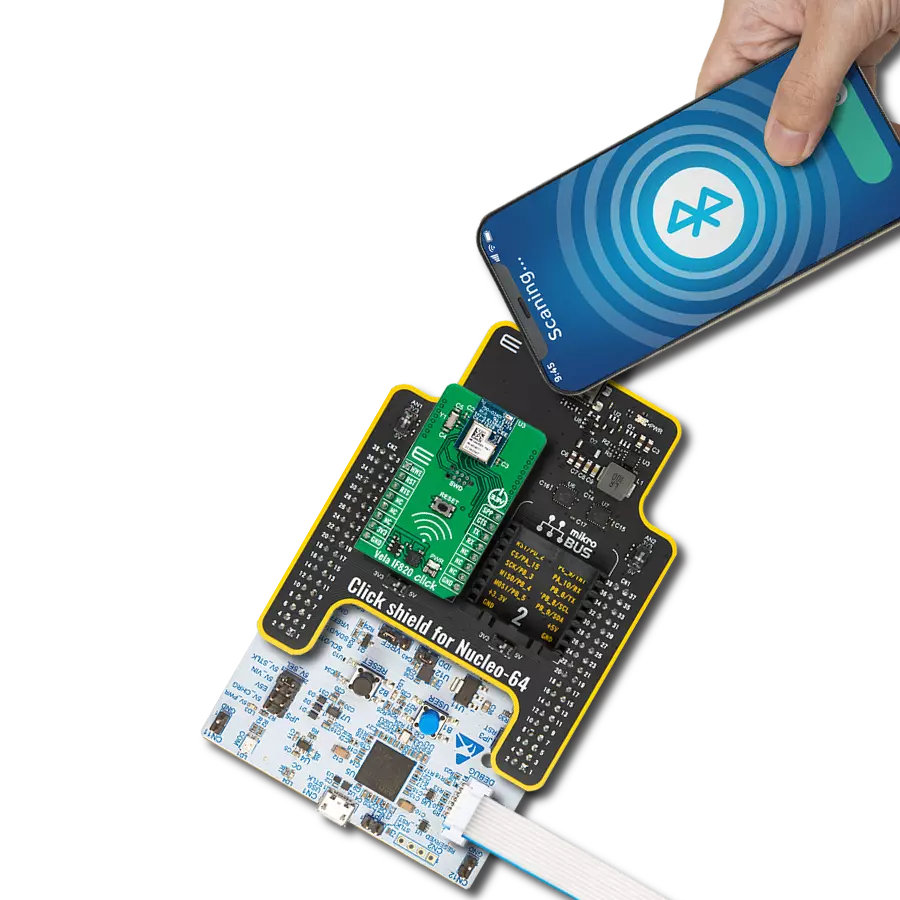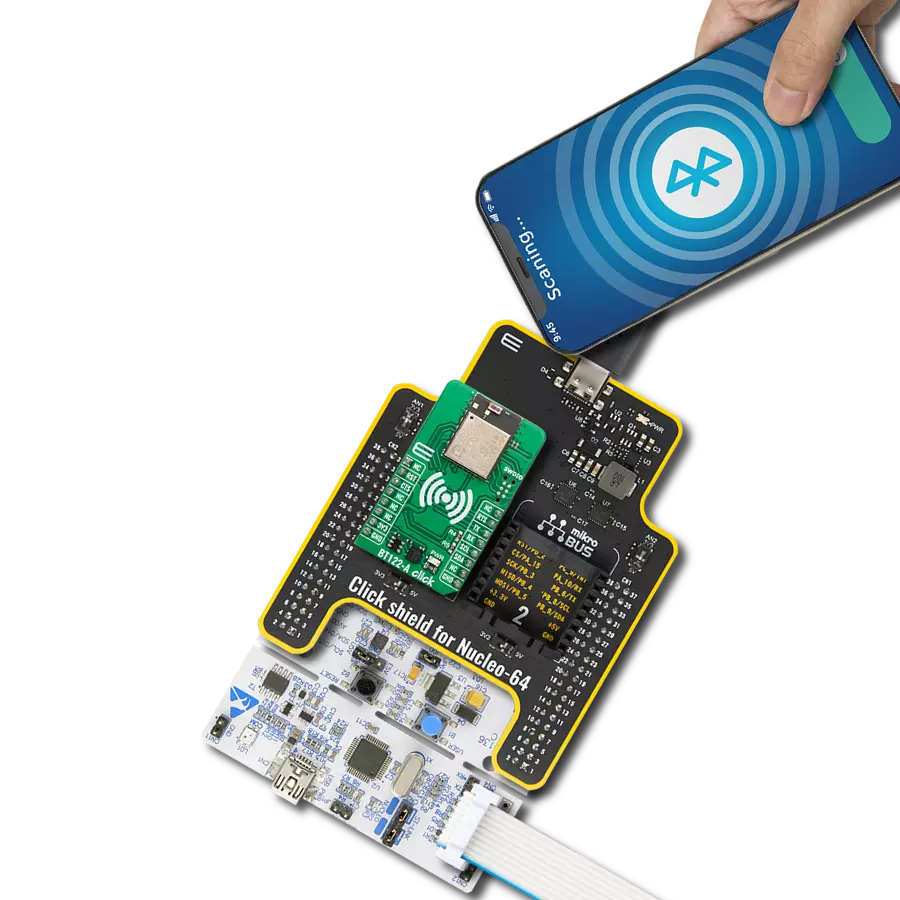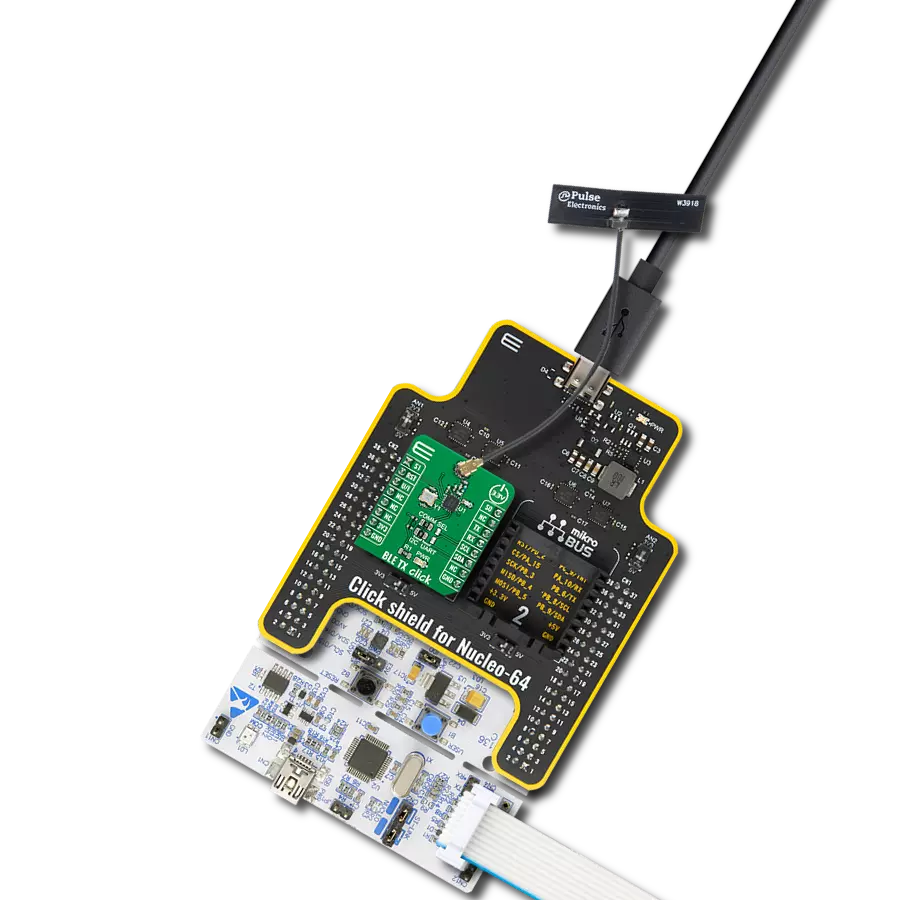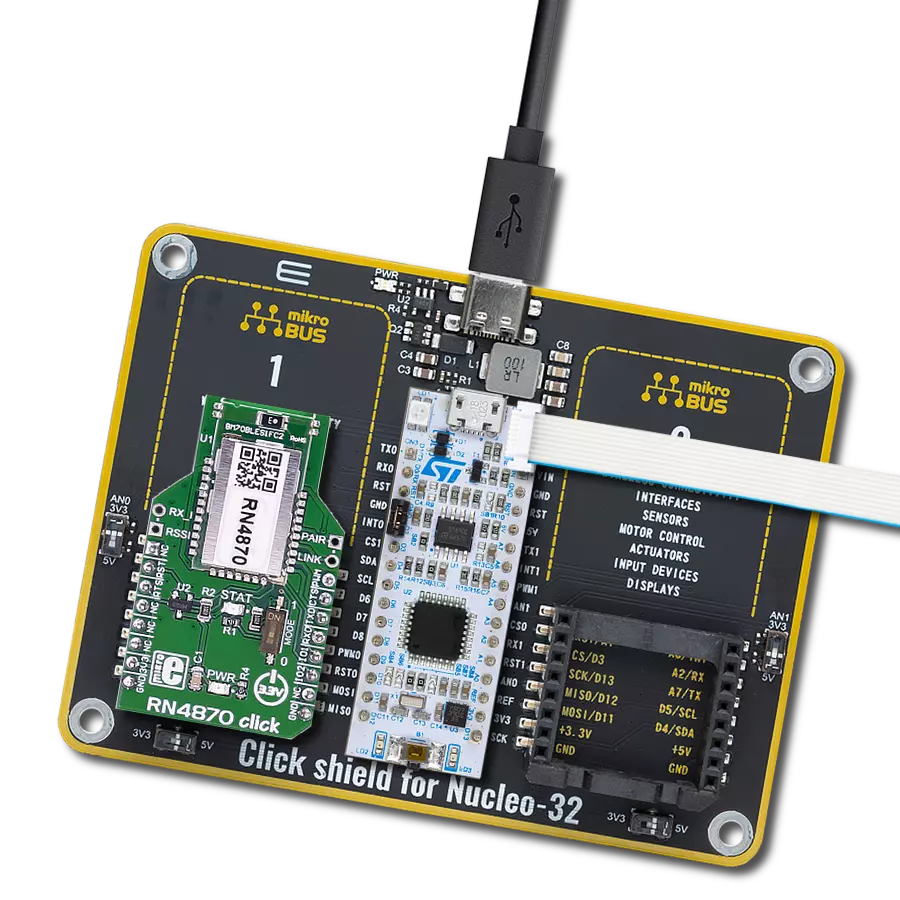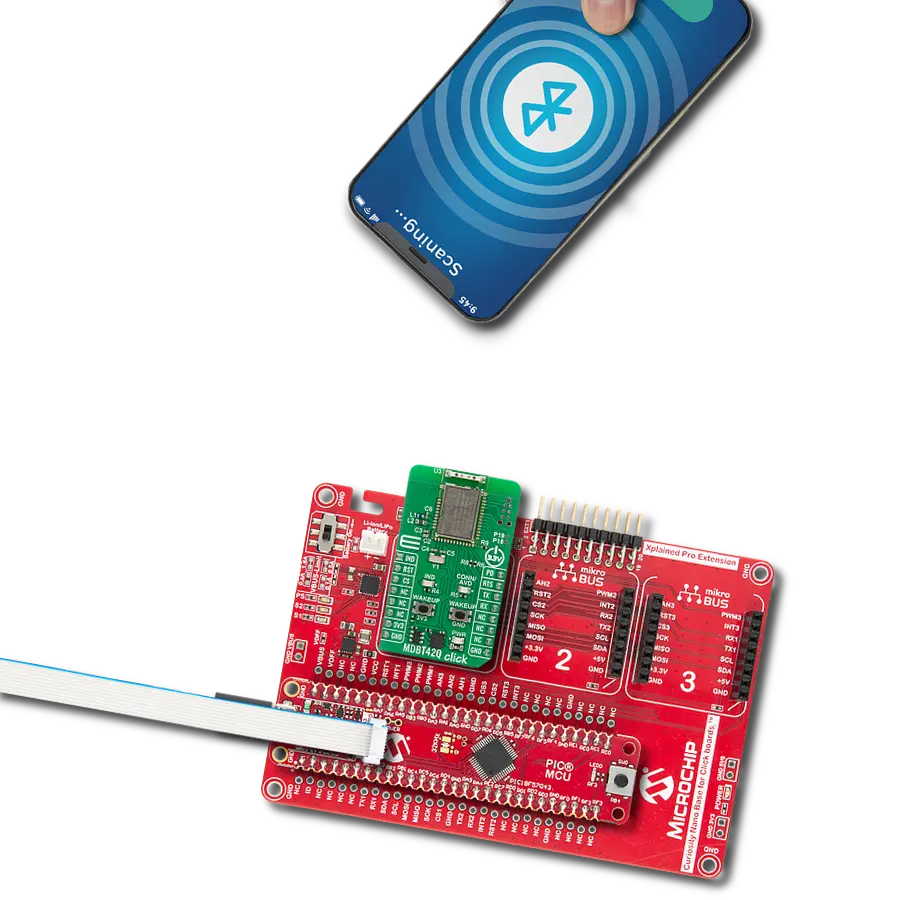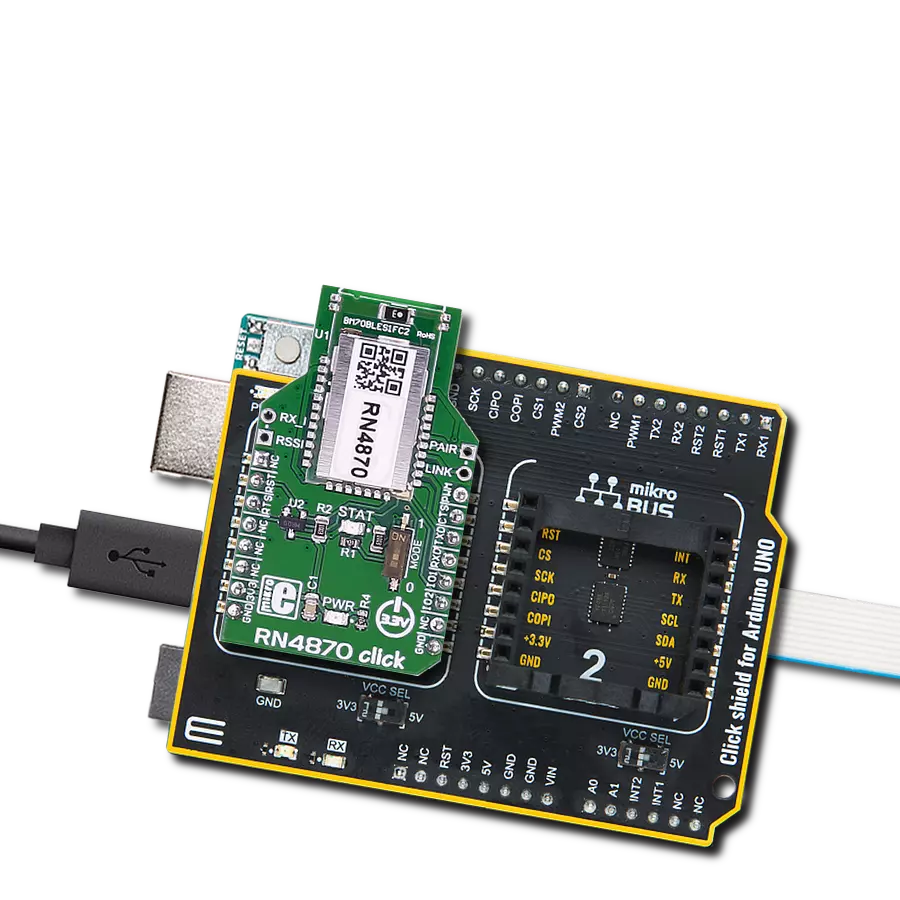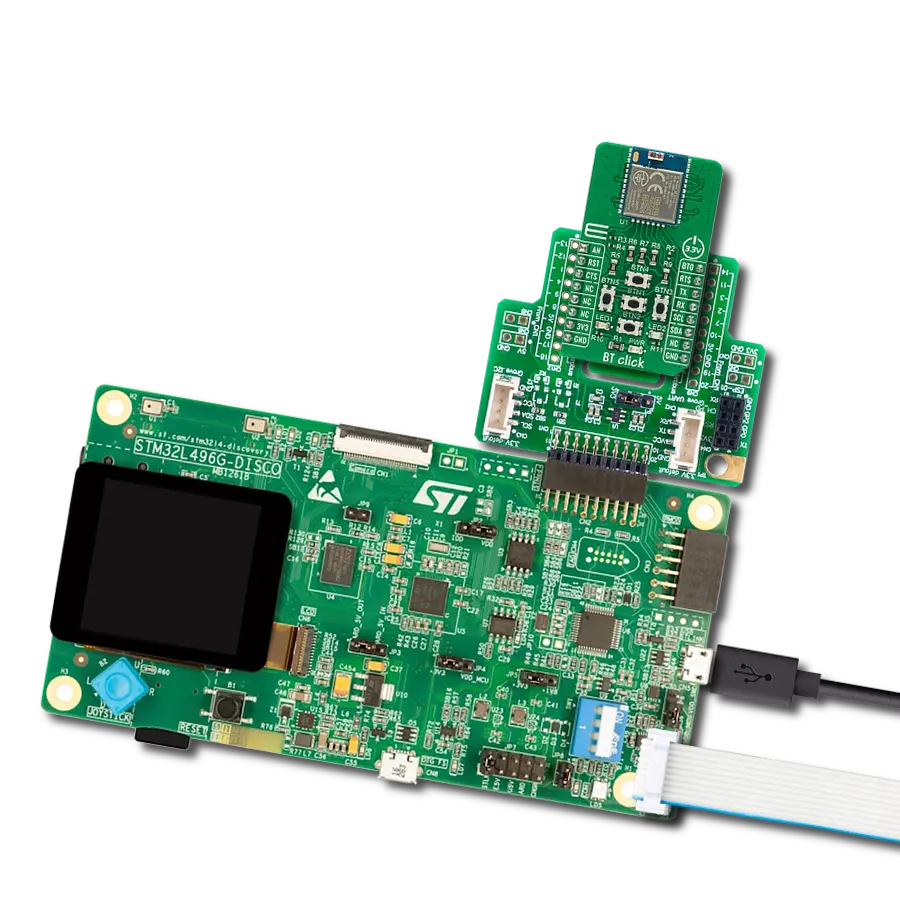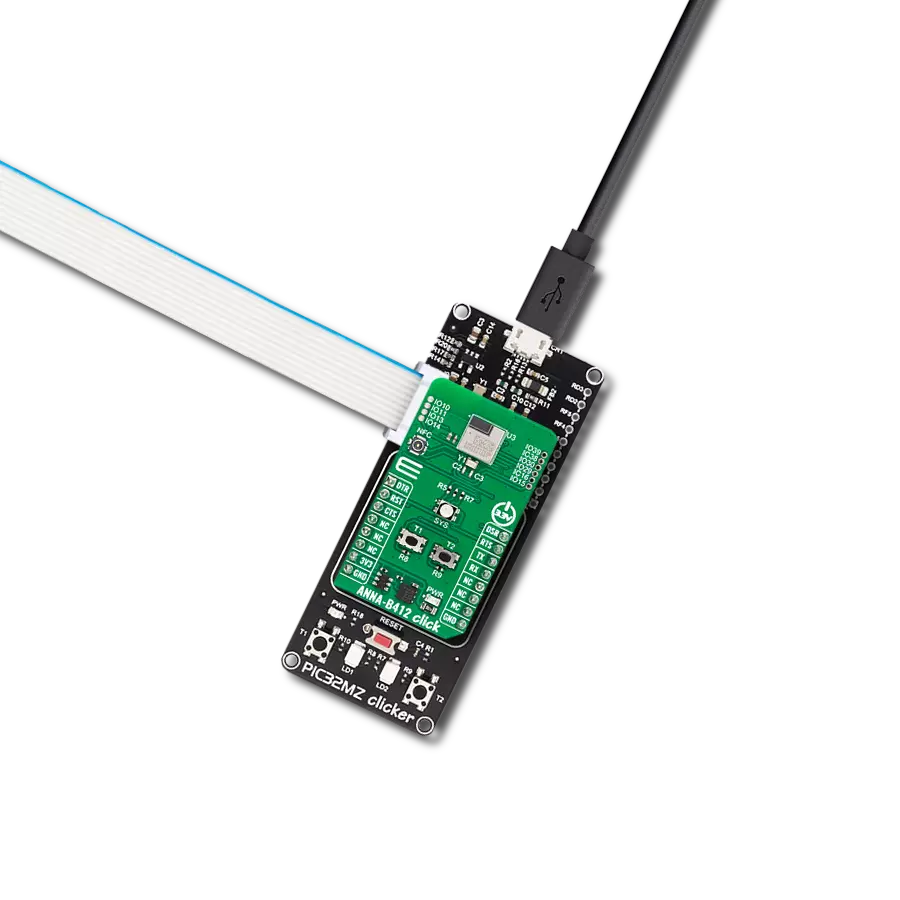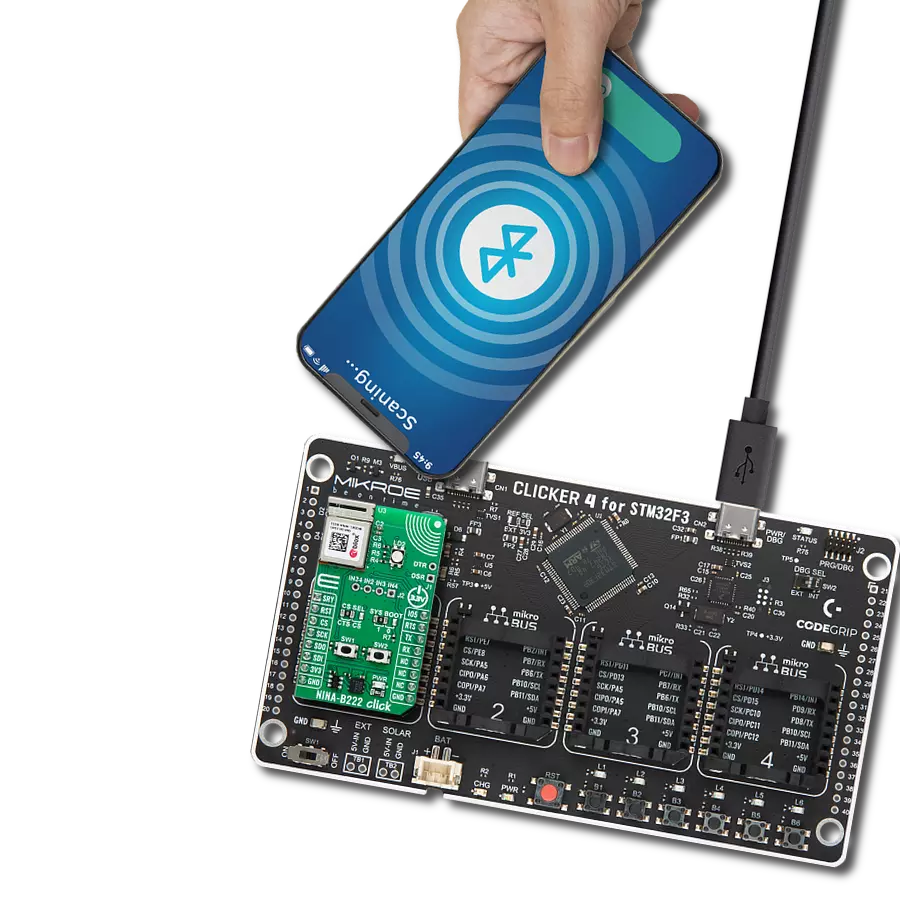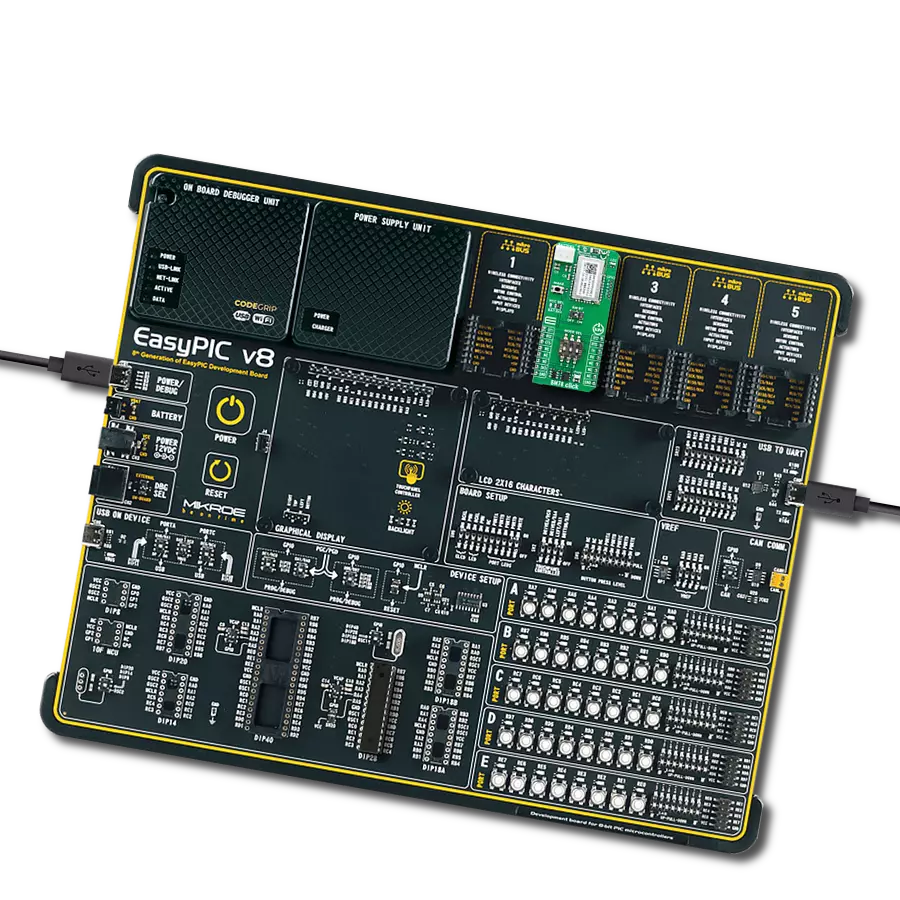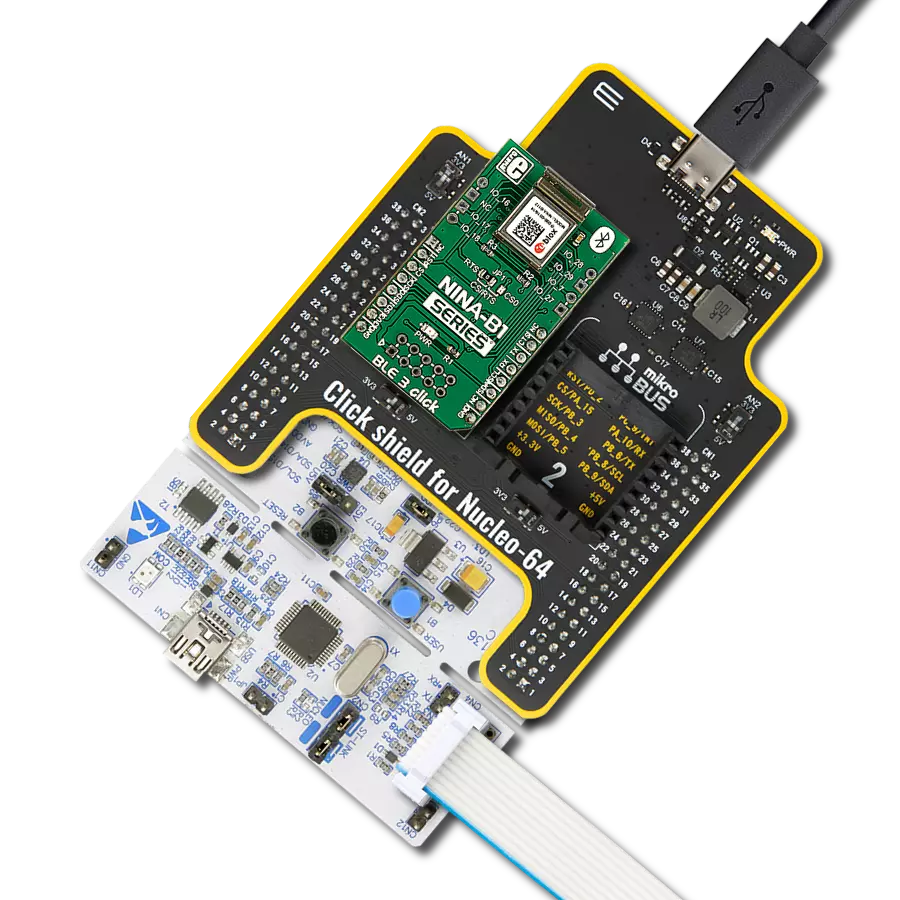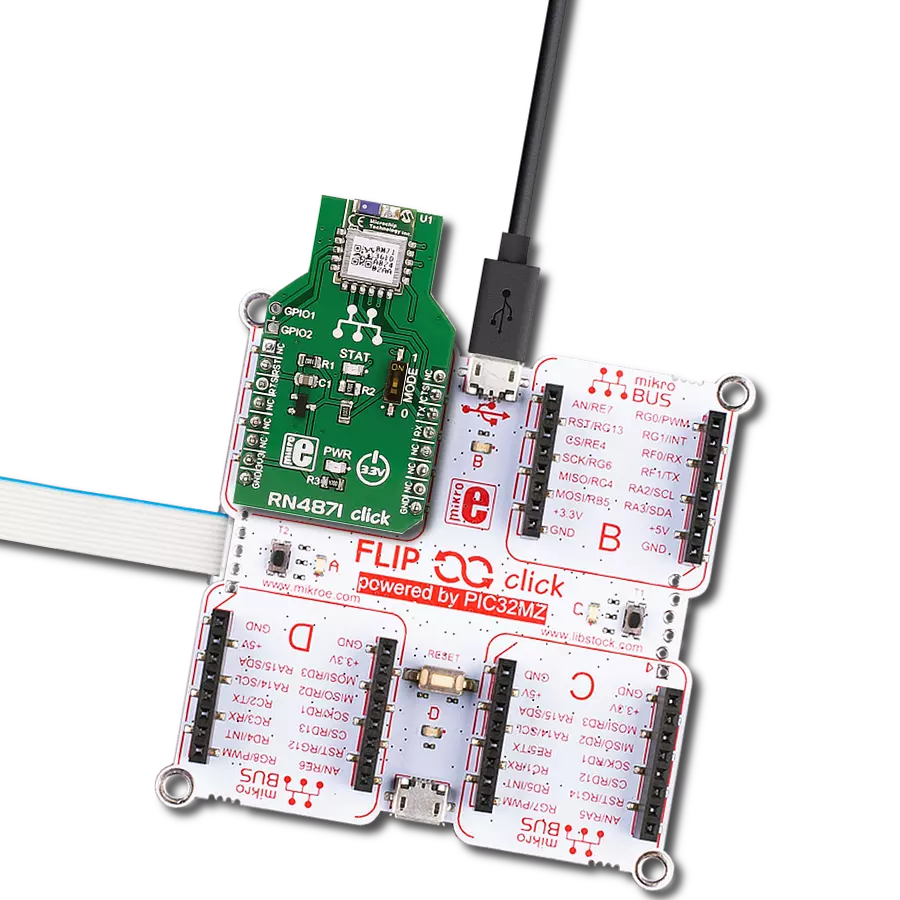Our Bluetooth 5 LE solution offers extended range and higher data throughput, enabling reliable and fast data transmission for a wide range of IoT and smart device applications.
A
A
Hardware Overview
How does it work?
BLE 4 Click is based on the NINA-B312, a stand-alone Bluetooth 5 low-energy module from u-blox, based on the nRF52840 chip. The nRF52840 is the mid-range member of the nRF52 Series SoC family. It meets the challenges of a broad range of applications requiring Bluetooth 5 feature sets, protocol concurrency, and a rich and varied set of peripherals and features. In addition, it offers generous memory availability for both Flash and RAM. It is operated by a set of AT commands over the UART interface, which makes the BLE 4 click very easy to use. By integrating most of the critical components on the chip, the NINA-B312 allows the module to overcome any imperfections of external discrete components, allowing signal transmission
power of up to 10dBm, and -94 dBm sensitivity for the receiver, using the on-chip antenna. The NINA-B312 module is built around an ARM® Cortex™-M4 CPU with a floating point unit running at 64 MHz. It has NFC-A Tag for use in simplified pairing and payment solutions and numerous digital peripherals and interfaces such as PDM. Therefore, BLE 4 Click has an onboard 2-pin header that can connect the optional NFC antenna. It is also fully multiprotocol capable with full protocol concurrency. It has protocol support for Bluetooth 5, Bluetooth mesh, and 2.4 GHz proprietary stacks. Besides the mikroBUS™ socket, BLE 4 click also features two onboard buttons, T1 and T2. These buttons can be used for various
purposes and are user-programmable. This Click Board™ also has an onboard user-programmable RGB LED - LD2, which, combined with the mentioned buttons, can be used for various purposes for basic user interaction without any external components required besides the BLE 4 click. This Click board™ can be operated only with a 3.3V logic voltage level. The board must perform appropriate logic voltage level conversion before using MCUs with different logic levels. Also, it comes equipped with a library containing functions and an example code that can be used, as a reference, for further development.
Features overview
Development board
Fusion for TIVA v8 is a development board specially designed for the needs of rapid development of embedded applications. It supports a wide range of microcontrollers, such as different 32-bit ARM® Cortex®-M based MCUs from Texas Instruments, regardless of their number of pins, and a broad set of unique functions, such as the first-ever embedded debugger/programmer over a WiFi network. The development board is well organized and designed so that the end-user has all the necessary elements, such as switches, buttons, indicators, connectors, and others, in one place. Thanks to innovative manufacturing technology, Fusion for TIVA v8 provides a fluid and immersive working experience, allowing access
anywhere and under any circumstances at any time. Each part of the Fusion for TIVA v8 development board contains the components necessary for the most efficient operation of the same board. An advanced integrated CODEGRIP programmer/debugger module offers many valuable programming/debugging options, including support for JTAG, SWD, and SWO Trace (Single Wire Output)), and seamless integration with the Mikroe software environment. Besides, it also includes a clean and regulated power supply module for the development board. It can use a wide range of external power sources, including a battery, an external 12V power supply, and a power source via the USB Type-C (USB-C) connector.
Communication options such as USB-UART, USB HOST/DEVICE, CAN (on the MCU card, if supported), and Ethernet is also included. In addition, it also has the well-established mikroBUS™ standard, a standardized socket for the MCU card (SiBRAIN standard), and two display options for the TFT board line of products and character-based LCD. Fusion for TIVA v8 is an integral part of the Mikroe ecosystem for rapid development. Natively supported by Mikroe software tools, it covers many aspects of prototyping and development thanks to a considerable number of different Click boards™ (over a thousand boards), the number of which is growing every day.
Microcontroller Overview
MCU Card / MCU
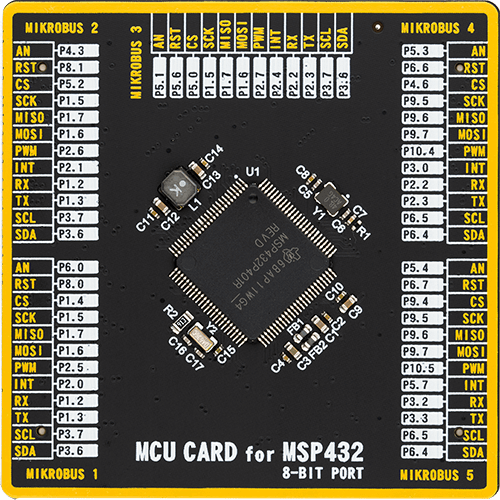
Type
8th Generation
Architecture
ARM Cortex-M4
MCU Memory (KB)
256
Silicon Vendor
Texas Instruments
Pin count
100
RAM (Bytes)
65536
Used MCU Pins
mikroBUS™ mapper
Take a closer look
Click board™ Schematic

Step by step
Project assembly
Software Support
Library Description
This library contains API for BLE 4 Click driver.
Key functions:
ble4_reset- This function allows user to reset a module
Open Source
Code example
The complete application code and a ready-to-use project are available through the NECTO Studio Package Manager for direct installation in the NECTO Studio. The application code can also be found on the MIKROE GitHub account.
/*!
* \file
* \brief BLE4 Click example
*
* # Description
* This example reads and processes data from BLE 4 Clicks.
*
* The demo application is composed of two sections :
*
* ## Application Init
* Initializes driver and wake-up module.
*
* ## Application Task
* Reads the received data and parses it.
*
* ## Additional Function
* - ble4_process ( ) - Logs all received messages on UART, and sends the certain message back to the connected device.
*
* \author MikroE Team
*
*/
// ------------------------------------------------------------------- INCLUDES
#include "board.h"
#include "log.h"
#include "ble4.h"
#include "string.h"
#define PROCESS_COUNTER 5
#define PROCESS_RX_BUFFER_SIZE 100
#define PROCESS_PARSER_BUFFER_SIZE 100
// ------------------------------------------------------------------ VARIABLES
static ble4_t ble4;
static log_t logger;
static uint8_t data_mode = 0;
static char current_parser_buf[ PROCESS_PARSER_BUFFER_SIZE ];
// ------------------------------------------------------- ADDITIONAL FUNCTIONS
static int8_t ble4_process ( void )
{
int32_t rsp_size;
uint16_t rsp_cnt = 0;
char uart_rx_buffer[ PROCESS_RX_BUFFER_SIZE ] = { 0 };
uint8_t check_buf_cnt;
uint8_t process_cnt = PROCESS_COUNTER;
// Clear current buffer
memset( current_parser_buf, 0, PROCESS_PARSER_BUFFER_SIZE );
while( process_cnt != 0 )
{
rsp_size = ble4_generic_read( &ble4, uart_rx_buffer, PROCESS_RX_BUFFER_SIZE );
if ( rsp_size > 0 )
{
// Validation of the received data
for ( check_buf_cnt = 0; check_buf_cnt < rsp_size; check_buf_cnt++ )
{
if ( uart_rx_buffer[ check_buf_cnt ] == 0 )
{
uart_rx_buffer[ check_buf_cnt ] = 13;
}
}
// Storages data in current buffer
rsp_cnt += rsp_size;
if ( rsp_cnt < PROCESS_PARSER_BUFFER_SIZE )
{
strncat( current_parser_buf, uart_rx_buffer, rsp_size );
}
// Clear RX buffer
memset( uart_rx_buffer, 0, PROCESS_RX_BUFFER_SIZE );
if (strstr(current_parser_buf, "ERROR")) {
return -1;
}
if (strstr(current_parser_buf, "OK")) {
log_printf( &logger, "%s", current_parser_buf );
Delay_100ms( );
return 1;
}
if ( data_mode == 1) {
log_printf( &logger, "%s", current_parser_buf );
uart_write( &ble4.uart, "Hello", 5 );
Delay_ms ( 1000 );
Delay_ms ( 1000 );
uart_write( &ble4.uart, "BLE4", 4 );
}
}
else
{
process_cnt--;
// Process delay
Delay_ms ( 100 );
}
}
return 0;
}
// ------------------------------------------------------ APPLICATION FUNCTIONS
void application_init ( void )
{
log_cfg_t log_cfg;
ble4_cfg_t cfg;
/**
* Logger initialization.
* Default baud rate: 115200
* Default log level: LOG_LEVEL_DEBUG
* @note If USB_UART_RX and USB_UART_TX
* are defined as HAL_PIN_NC, you will
* need to define them manually for log to work.
* See @b LOG_MAP_USB_UART macro definition for detailed explanation.
*/
LOG_MAP_USB_UART( log_cfg );
log_init( &logger, &log_cfg );
log_info( &logger, "---- Application Init ----" );
// Click initialization.
ble4_cfg_setup( &cfg );
BLE4_MAP_MIKROBUS( cfg, MIKROBUS_1 );
ble4_init( &ble4, &cfg );
ble4_reset( &ble4 );
Delay_1sec( );
log_printf( &logger, "Configuring the module...\n" );
Delay_1sec( );
ble4_set_dsr_pin( &ble4, 1 );
Delay_ms ( 20 );
do {
ble4_set_echo_cmd( &ble4, 1 );
Delay_100ms( );
}
while( ble4_process( ) != 1 );
do {
ble4_set_local_name_cmd( &ble4, "BLE 4 Click" );
Delay_100ms( );
}
while( ble4_process( ) != 1 );
do {
ble4_connectability_en_cmd( &ble4, BLE4_GAP_CONNECTABLE_MODE );
Delay_100ms( );
}
while( ble4_process( ) != 1 );
do {
ble4_discoverability_en_cmd( &ble4, BLE4_GAP_GENERAL_DISCOVERABLE_MODE );
Delay_100ms( );
}
while( ble4_process( ) != 1 );
do {
ble4_enter_mode_cmd( &ble4, BLE4_DATA_MODE );
Delay_100ms( );
}
while( ble4_process( ) != 1 );
ble4_set_dsr_pin( &ble4, 0 );
Delay_ms ( 20 );
data_mode = 1;
log_printf( &logger, "The module has been configured.\n" );
}
void application_task ( void )
{
ble4_process( );
}
int main ( void )
{
/* Do not remove this line or clock might not be set correctly. */
#ifdef PREINIT_SUPPORTED
preinit();
#endif
application_init( );
for ( ; ; )
{
application_task( );
}
return 0;
}
// ------------------------------------------------------------------------ END

















